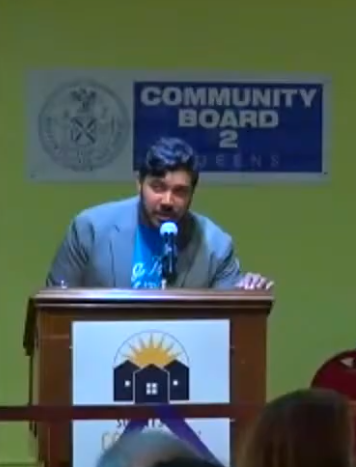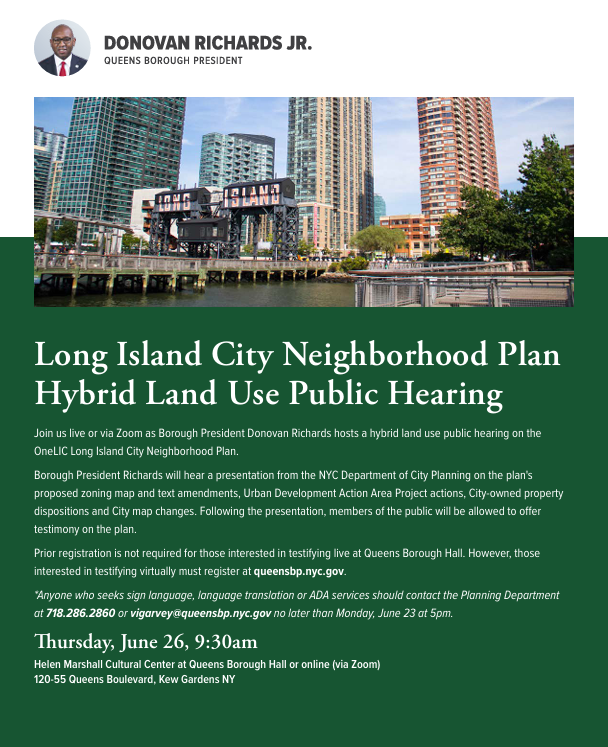
OneLIC Neighborhood Plan will update outdated zoning and expand access to the waterfront. Image Credit: DCP.
June 19, 2025 By Shane O’Brien
Community Boards 1 and 2 have both voted to support the city’s OneLIC Neighborhood Plan—with conditions— and described the vote as a “hard-fought endorsement of a more equitable Long Island City.”
Community Board 2 passed a non-binding resolution on Wednesday night with a 37-7 vote in favor of the proposed rezoning as part of the city’s Uniform Land Use Review Procedure (ULURP). One day earlier, Community Board 1 approved the plan with conditions by a vote of 22-11.
CB2 Chair Anatole Ashraf told Queens Post that he was “proud” that the community board voted in favor of the plan with conditions by a significant majority.
The board’s conditional approval calls for greater commitments to deep affordability, as well as investment in critical neighborhood amenities such as schools, open space and infrastructure.
CB2 also emphasized the need for binding accountability mechanisms to ensure that community priorities—shaped during an 18-month public engagement process—are meaningfully implemented.

CB2 Chair Anatole Ashraf speaks during the board’s June meeting, calling the vote “a clear-eyed, hard-fought endorsement of a more equitable, livable Long Island City.” Screengrab via YouTube
“This is not a blank check,” said Ashraf. “It was a clear-eyed, hard-fought endorsement of a more equitable, livable Long Island City.
“We’ve demanded deep affordability, infrastructure that grows with housing, real investments in schools and open space, and binding accountability mechanisms.”
Ashraf said the board’s vote—with 37 in favor, seven opposed, and one abstention—reflects CB2’s commitment to helping solve New York City’s housing crisis while also securing meaningful benefits for local neighborhoods. He acknowledged the concerns raised by many residents during a contentious 60-day public comment period, during which several community members urged the board to reject the plan.
Ashraf emphasized that the vote was conditional and structured to ensure community concerns are addressed as the proposal continues through the Uniform Land Use Review Procedure (ULURP).
“This vote ensures that as the plan advances, our communities’ priorities are locked in and ready to be fought for at every step of the process,” he said.
The Adams administration and the Department of City Planning (DCP) have touted the OneLIC Neighborhood Plan as a transformative initiative that would reshape a 50-block area of Long Island City with updated zoning to allow for more mixed-use development, greater housing supply, and long-term resiliency.
According to the city, the plan would generate nearly 14,700 new housing units, including 4,300 affordable homes. It is also expected to create approximately 14,400 jobs, more than 3.5 million square feet of commercial and industrial space, and significantly expanded access to the East River waterfront.
The rezoning area spans from Gantry Plaza State Park to the Queensbridge Houses, reaching north to the Long Island City Industrial Business Zone, and extending east to Court Square and 23rd Street. The plan includes nearly nine acres of new public open space, expanded parks and plazas, improved pedestrian infrastructure, and an updated Waterfront Access Plan aimed at connecting Gantry Plaza State Park to Queensbridge Park via a unified esplanade.

OneLIC Neighborhood Plan would unify the waterfront from Gantry Plaza State Park to
Queensbridge Park, creating a consistent public space for the neighborhood. Image Credit: DCP.
A major component of the plan is the proposed transformation of the six-story, 672,000-square-foot Department of Education building at 44-36 Vernon Blvd., which city officials say could be adapted for housing, light industrial use, cultural facilities, or community-serving spaces.
Officials add that publicly owned sites within the rezoning area may also support green infrastructure and other public-serving uses.
Despite those promises, critics have warned that the plan disproportionately favors developers and could accelerate displacement by increasing luxury development without legally binding commitments to affordability or public infrastructure.
At a heated public hearing last month at LaGuardia Community College, several opponents argued that the plan lacks enforceable guarantees around open space, school seats, and infrastructure investments.
In response, sources close to Council Member Julie Won clarified that she has no intention of supporting the rezoning in its current form. Won has stated she will only vote in favor during the City Council’s final ULURP decision if the plan includes explicit and enforceable commitments to community priorities.
The community board recommendations are advisory but influential. Within 30 days, Queens Borough President Donovan Richards is expected to issue his own advisory opinion on the plan.
The proposal will then go before the City Planning Commission for a hearing and vote, followed by a final decision by the New York City Council, where Council Member Won’s vote will likely determine its fate. The mayor has the authority to veto the plan within five days of the Council’s decision.
Borough President Richards will host a Land Use Public Hearing on the OneLIC proposal on Thursday, June 26.







